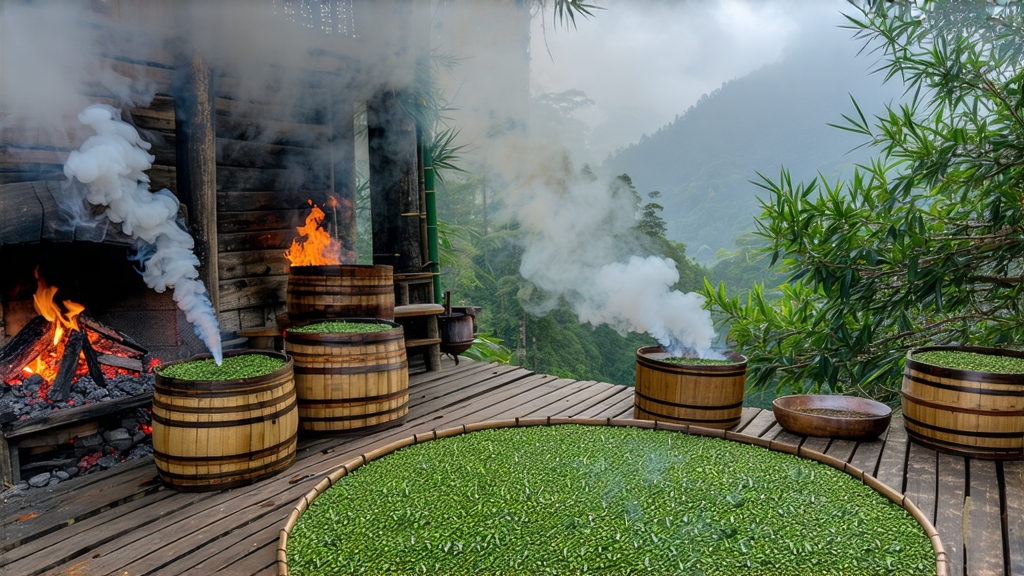
When European tea clippers first rounded the Cape of Good Hope in the late 1600s, the chests they carried bore a mysterious inscription: “Bohea Souchong.” That name, a corruption of the Fujianese “Wuyi xiao zhong,” referred to the earliest intentionally oxidised leaf the West would ever taste—what we now call black tea. Centuries later, the original style survives as Lapsang Souchong, a tea whose perfume of pine smoke and longan fruit still whispers of the granite gorges and camphor-scented forests of northern Fujian’s Wuyi Mountains. To understand Chinese black tea is to begin here, with the cultivar that taught the world how leaves can be coaxed from green to copper, and how fire can be invited into flavour without burning the soul of the leaf.
History: From Monastic Mist to London Drawing Rooms
Legend places the birth of Lapsang Souchong in the Tongmu Guan village during the Ming dynasty. A passing army, so the story goes, commandeered a tea workshop, forcing farmers to dry their leaf hurriedly over fresh pine fires so it could be rushed to market. Whatever the truth, by 1604 Dutch merchants were selling this smoky novelty in Paris and London at prices higher than silver. The East India Company soon standardised the grade as “Bohea,” a term that embraced the entire Wuyi range yet reserved its top tier for the finest “souchong”—literally “small sort”—picked from the lower two leaves and a bud of the spring flush. When Queen Victoria tasted it at Balmoral, she declared it “fit for the gods,” and afternoon tea acquired its first dark leaf. Thus, a rustic Fujianese response to logistical chaos became the prototype for every future black tea from Assam to Ceylon.
Terroir: Why Only Tongmu Tastes Like Tongmu
The Wuyi massif is a UNESCO biosphere where subtropical humidity collides with mineral-rich granite soils. At 1 200–1 500 m, morning fog lingers until noon, filtering sunlight into a soft, diffused glow that slows photosynthesis and concentrates amino acids. Wild camphor, cinnamon, and bamboo root systems share the same mycorrhizal networks as the tea bushes, adding resinous and sweet undercurrents to the leaf. Crucially, the village of Tongmu sits inside a national nature reserve; pesticides are forbidden and only a handful of registered families may still produce authentic Lapsang. The result is a micro-climate impossible to replicate even twenty kilometres away, a living argument for the Chinese concept of diwei—taste of place.
Cultivars: Three Bushes That Smoke
Most Lapsang is made from the Wuyi Caicha cultivar, a hardy landrace that germinates late, resisting the valley’s final spring frosts. Its leaves are small, slightly twisted, and high in catechins—ideal for absorbing smoke without turning acrid. A second variant, the Zhenghe Da Bai, yields a plumper bud and thicker cell walls, giving a creamier liquor favoured in eastern European markets. The rarest is the wild-growing Qi Zhong (“strange bush”), scattered across cliff ledges reachable only by rope. Harvested once every three years, its leaf carries natural menthol notes that marry with pine in a scent reminiscent of cedar and mint chocolate.
Craft: The Eight Stages of Controlled Fire
Authentic Lapsang is still handmade in three-storey wooden houses whose top floors are drying lofts, middle floors withering racks, and ground floors smoking chambers. The process begins at dusk: baskets of freshly plucked leaves are laid on bamboo screens above charcoal braziers fed by local Masson pine. The temperature is held at 28–30 °C for eight hours while artisans gently turn the leaf every twenty minutes, allowing moisture to evaporate without bruising the cells. At dawn the leaf is rolled on split bamboo trays; pressure is applied by palm alone, rupturing cell walls just enough to release oxidative enzymes. Oxidation itself occurs in pine-wood boxes lined with wet cloth; the humidity keeps the leaf supple while the wood’s resin perfumes the air. When the leaf has turned milk-chocolate brown, it is given a final “firing” over embers of long-leaf pine and a sprinkle of fresh